




ou can hurt with your words but sometimes you can hurt more with your silence.
 The view from my campsite, looking northeast.
The view from my campsite, looking northeast. Looking southeast.
Looking southeast. From the north side of the park, looking toward the west. The campground was nestled amongst the trees on the western shore.
From the north side of the park, looking toward the west. The campground was nestled amongst the trees on the western shore.

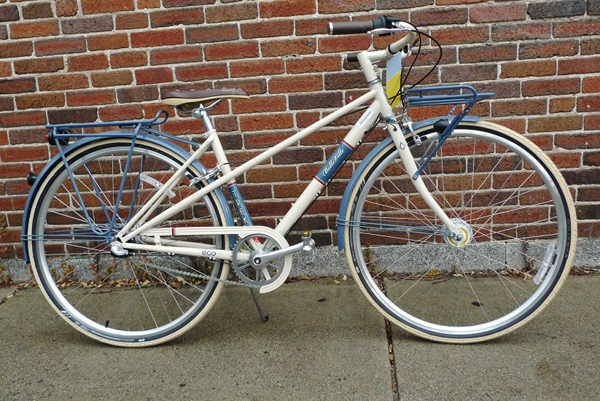 Lately, readers have been asking about the Trek Belleville WSD mixte. It has been out for about a year and looks promising in pictures, but what is it like in person? I had noticed this bicycle earlier at one of my local bike shops - theWheelworks in Somerville, MA - and recently had a chance to try it.
Lately, readers have been asking about the Trek Belleville WSD mixte. It has been out for about a year and looks promising in pictures, but what is it like in person? I had noticed this bicycle earlier at one of my local bike shops - theWheelworks in Somerville, MA - and recently had a chance to try it.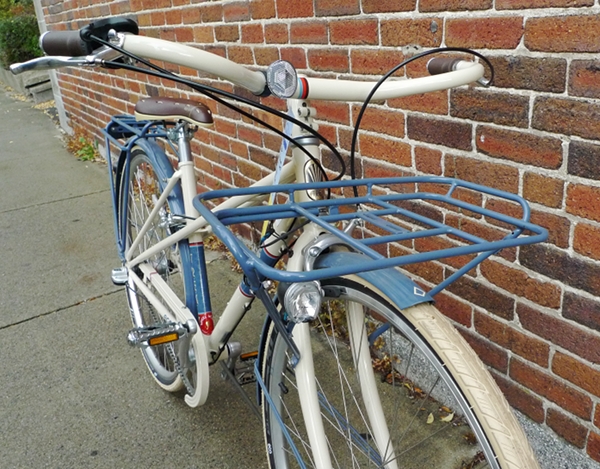 The Trek Bellevillemixte is a "real" mixte - in the sense that it is built with twin lateral stays that extend from the head tube to the rear dropouts. The bicycle reflects the ideas of the French constructeurs (or, more likely, the contemporary builders who emulatethe original constructeurs) in that it is fully equipped with fenders, front and rear racks, and dynamo-powered lighting. However, unlike classic mixtes with their elegant lines and lugged steel construction, theTrek Belleville's frameis made of a strangely thick, welded cromoly tubing. The tubing is so chunky in fact, that I was certain the bike was aluminum until I was corrected. In industry photos the chunkiness is easily disguised with good lighting and careful choice of angles. But in person, the bicycle looks like what it is: a somewhat clumsy mass-produced bike fitted with some admittedly impressive extras. Trek also promotes the "eco-design" of this model, which you can read about here.
The Trek Bellevillemixte is a "real" mixte - in the sense that it is built with twin lateral stays that extend from the head tube to the rear dropouts. The bicycle reflects the ideas of the French constructeurs (or, more likely, the contemporary builders who emulatethe original constructeurs) in that it is fully equipped with fenders, front and rear racks, and dynamo-powered lighting. However, unlike classic mixtes with their elegant lines and lugged steel construction, theTrek Belleville's frameis made of a strangely thick, welded cromoly tubing. The tubing is so chunky in fact, that I was certain the bike was aluminum until I was corrected. In industry photos the chunkiness is easily disguised with good lighting and careful choice of angles. But in person, the bicycle looks like what it is: a somewhat clumsy mass-produced bike fitted with some admittedly impressive extras. Trek also promotes the "eco-design" of this model, which you can read about here. 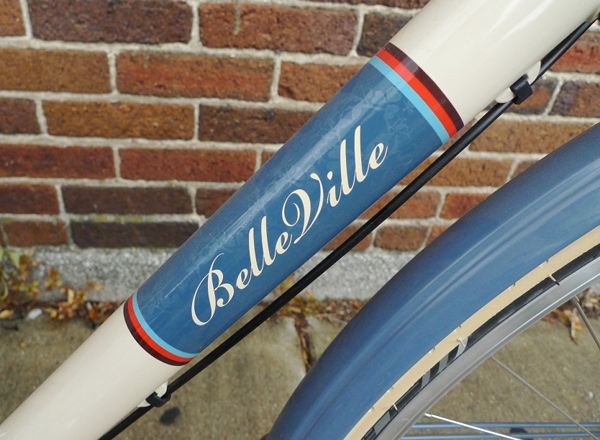 I think that one of the most successful aspects of theTrek Bellevilleis the colour scheme and graphics. We like to fool ourselves into thinking that this stuff does not influence us, but it does. The slate-blue and cream colour combination with subtle red accents is harmonious, beautiful, and nostalgic. It dominates the aesthetics of the bicycle, distracting the eye from its less appealing aspects.
I think that one of the most successful aspects of theTrek Bellevilleis the colour scheme and graphics. We like to fool ourselves into thinking that this stuff does not influence us, but it does. The slate-blue and cream colour combination with subtle red accents is harmonious, beautiful, and nostalgic. It dominates the aesthetics of the bicycle, distracting the eye from its less appealing aspects. Trek also used a vintage headbadge for the Belleville, which goes nicely with the classic theme.
Trek also used a vintage headbadge for the Belleville, which goes nicely with the classic theme.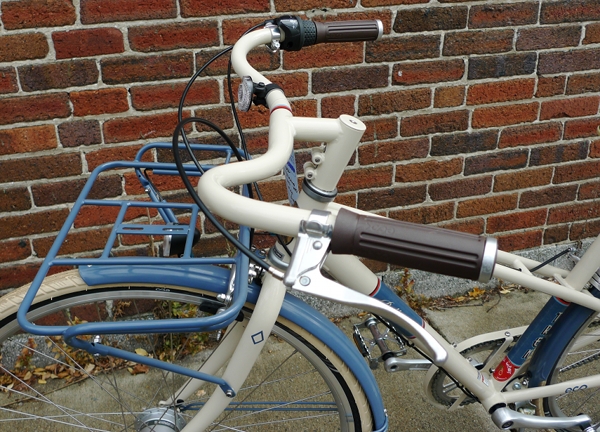 The Trek Belleville uses a threadless stem and Porteur-style handlebars. Both the stem and the handlebars are painted body colour, which is nice. A Porteur-style front rack is attached to the fork.
The Trek Belleville uses a threadless stem and Porteur-style handlebars. Both the stem and the handlebars are painted body colour, which is nice. A Porteur-style front rack is attached to the fork.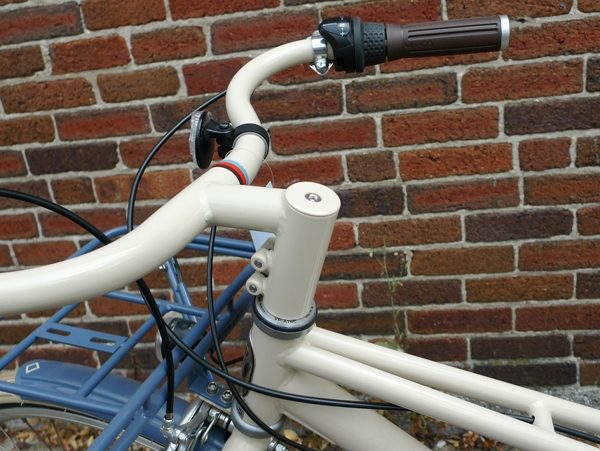 Close-up of the stem, grips, shifter and the points where the lateral stays attach to the head tube. While I do not normally like threadless stems and integrated handlebars, I think here the look is appealing. However, the design makes it impossible to adjust stem height and the angle of the handlebars, which is problematic.
Close-up of the stem, grips, shifter and the points where the lateral stays attach to the head tube. While I do not normally like threadless stems and integrated handlebars, I think here the look is appealing. However, the design makes it impossible to adjust stem height and the angle of the handlebars, which is problematic.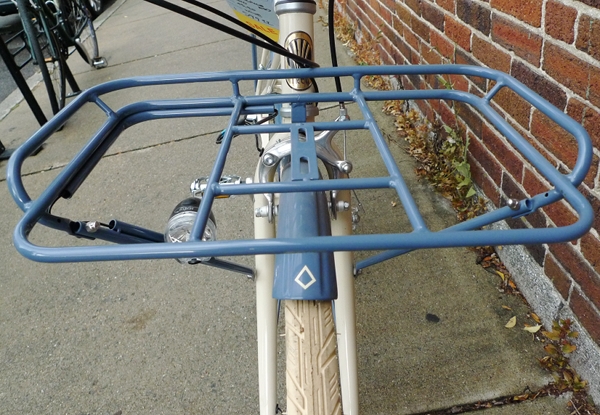 The front rack is quite elegant, as well as smoothly integrated with the body of the bike. The tires are Bontrager, cream with black sidewalls.
The front rack is quite elegant, as well as smoothly integrated with the body of the bike. The tires are Bontrager, cream with black sidewalls. The rear rack is nice as well. I don't remember the weight rating, but it was considerable. One thing I noticed, is that the attachment points are set back from the rear dropouts - presumably because the chainstays are otherwise not long enough to accommodate a rack?
The rear rack is nice as well. I don't remember the weight rating, but it was considerable. One thing I noticed, is that the attachment points are set back from the rear dropouts - presumably because the chainstays are otherwise not long enough to accommodate a rack? TheTrek Bellevilleis fitted with an internally geared hub (Shimano Nexus 3-speed), caliper brakes, a decent-looking crankset, touring-style pedals, and a body-coloured chainguard.
TheTrek Bellevilleis fitted with an internally geared hub (Shimano Nexus 3-speed), caliper brakes, a decent-looking crankset, touring-style pedals, and a body-coloured chainguard. The front dynamo hub is a Shimano (I did not see the model name), and the lights used are Spanniga. The headlight is a Spanniga Micro, mounted on right stay of the front rack.
The front dynamo hub is a Shimano (I did not see the model name), and the lights used are Spanniga. The headlight is a Spanniga Micro, mounted on right stay of the front rack. The tail light is a Spanniga Eclipse, attached to the rear rack. I have not tried the lights, as it was daytime, but I have heard good things about these models.
The tail light is a Spanniga Eclipse, attached to the rear rack. I have not tried the lights, as it was daytime, but I have heard good things about these models.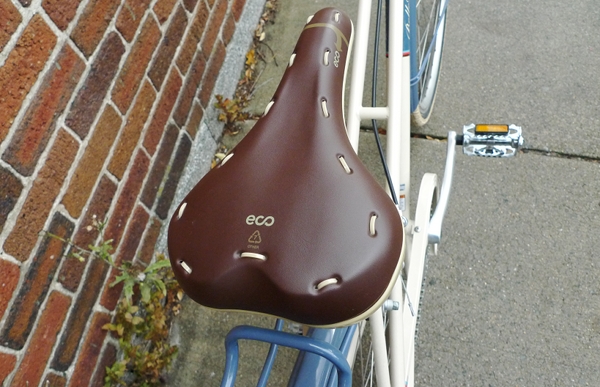 The saddle has a faux-handsewn leather look to it and feels like a typical padded vinyl saddle. I have read that it was designed to be disassembled and recycled after use, though I am not clear on the details.
The saddle has a faux-handsewn leather look to it and feels like a typical padded vinyl saddle. I have read that it was designed to be disassembled and recycled after use, though I am not clear on the details.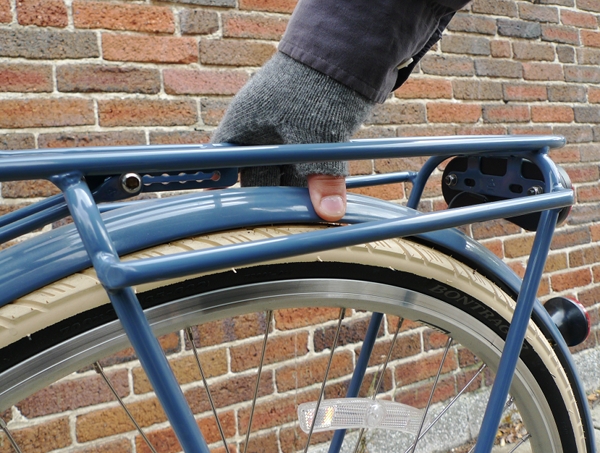 I would estimate the weight of the Bellevillemixte around 35lbs. Very reasonable, considering the steel tubing and all the extras.
I would estimate the weight of the Bellevillemixte around 35lbs. Very reasonable, considering the steel tubing and all the extras.  I test-rode the Trek Belleville mixte briefly, and I apologise for my disgraceful "salmoning" - it was only done for the photo. As reflected in the picture, the first thing I noted was the unusually generous width of the handlebars - I almost felt as if I were holding the edges of a hula hoop. Maybe this was the cause of the strange feel to the steering, because I found the front end to be "aloof" - almost as if it was receiving its steering instructions via a third party rather than from me directly. I wonder whether it would handle differently with a front load, but that is not something I was able to test. Otherwise, the ride felt okay - with the exception perhaps of too much pressure on my hands despite the upright handlebars.
I test-rode the Trek Belleville mixte briefly, and I apologise for my disgraceful "salmoning" - it was only done for the photo. As reflected in the picture, the first thing I noted was the unusually generous width of the handlebars - I almost felt as if I were holding the edges of a hula hoop. Maybe this was the cause of the strange feel to the steering, because I found the front end to be "aloof" - almost as if it was receiving its steering instructions via a third party rather than from me directly. I wonder whether it would handle differently with a front load, but that is not something I was able to test. Otherwise, the ride felt okay - with the exception perhaps of too much pressure on my hands despite the upright handlebars. the Atlantis
the Atlantis the original green Sam Hillborne
the original green Sam Hillborne the orange Sam Hillborne
the orange Sam Hillborne the A. Homer Hilsen
the A. Homer Hilsen the Betty Foy
the Betty Foy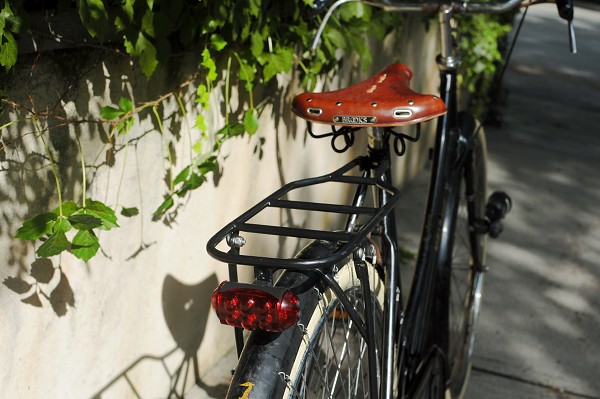 As some have astutely observed in the previous post, my Raleigh DL-1 now has a rear rack! It is notoriously difficult to find racks that will properly fit these bicycles (without slanting), and the racks that originally came with DL-1s are almost impossible to get ahold of. This here is a prototype for a custom rack by Red Barn Classic Bicycle Accessories, designed and built by metalsmith Jon Gehman with some input from me, specifically to fit the vintage Raleigh DL-1.
As some have astutely observed in the previous post, my Raleigh DL-1 now has a rear rack! It is notoriously difficult to find racks that will properly fit these bicycles (without slanting), and the racks that originally came with DL-1s are almost impossible to get ahold of. This here is a prototype for a custom rack by Red Barn Classic Bicycle Accessories, designed and built by metalsmith Jon Gehman with some input from me, specifically to fit the vintage Raleigh DL-1. The Roadster Rack was built based on the dimensions of the original racks that were typically used with the DL-1, but features some delightful add-ons.
The Roadster Rack was built based on the dimensions of the original racks that were typically used with the DL-1, but features some delightful add-ons.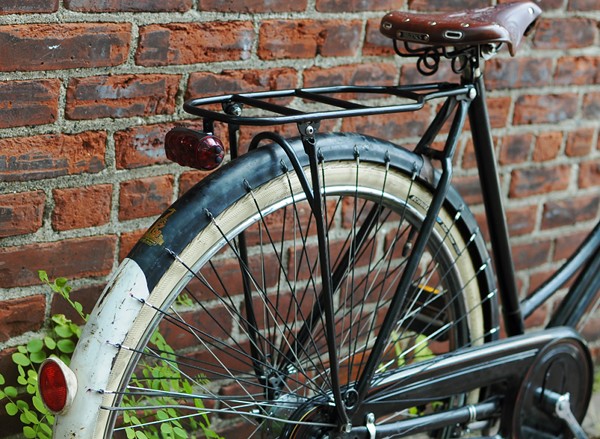 The platform of the rack is fortified with a graceful arch - something the original lacks. There is also a handy light mount at the end for attaching a tail light.
The platform of the rack is fortified with a graceful arch - something the original lacks. There is also a handy light mount at the end for attaching a tail light. Here is a detail shot. The Roadster Rack is made of 3/8" seamless aircraft chrom-moly tubing; brazed and silver soldered. It is enamel painted, and the matte finish is a good match for the aged paint on my bicycle.
Here is a detail shot. The Roadster Rack is made of 3/8" seamless aircraft chrom-moly tubing; brazed and silver soldered. It is enamel painted, and the matte finish is a good match for the aged paint on my bicycle. The rack also features these nice loops for attaching bungee cords. Needless to say, these are extremely useful.
The rack also features these nice loops for attaching bungee cords. Needless to say, these are extremely useful. Though the functionality of the rack is impeccable, I have to say that - at least for me - the practical aspects are overshadowed by the looks. I am not sure how well my pictures portray this, but the lines of the rack are mesmerisingly graceful. The arch, the light mount, the bungee loops, and even the gentle curves of the platform itself - everything is perfectly proportioned and pleasing to the eye. It makes me feel like a criminal for having now attached a set of Wald folding baskets to my rack - but hey, I needed to carry my laptop bag!
Though the functionality of the rack is impeccable, I have to say that - at least for me - the practical aspects are overshadowed by the looks. I am not sure how well my pictures portray this, but the lines of the rack are mesmerisingly graceful. The arch, the light mount, the bungee loops, and even the gentle curves of the platform itself - everything is perfectly proportioned and pleasing to the eye. It makes me feel like a criminal for having now attached a set of Wald folding baskets to my rack - but hey, I needed to carry my laptop bag!




 Page 404
Page 404
 Adventure in one hand and failure in the other...some times a handful makes an unforgetable trip.
Adventure in one hand and failure in the other...some times a handful makes an unforgetable trip.

 In the excitement of describing the A.N.T. Open House, I forgot to mention that on the same weekend I picked up my Raleigh DL1 Lady's Tourist from the shop.
In the excitement of describing the A.N.T. Open House, I forgot to mention that on the same weekend I picked up my Raleigh DL1 Lady's Tourist from the shop. Here she is, in her restored glory. See this post for the "before" shots.
Here she is, in her restored glory. See this post for the "before" shots. The DL1 had an extensive tune up that included bottom bracket replacement, rod brake adjustment, and lowered gearing (22 tooth rear cog) to make climbing hills easier.
The DL1 had an extensive tune up that included bottom bracket replacement, rod brake adjustment, and lowered gearing (22 tooth rear cog) to make climbing hills easier. Then of course there are the aesthetic changes: The old tires have been replace with the gorgeous cream Schwalbe Delta Cruisers, a full chaincase and vintage-style rope dressguards have been installed, and a frame pump has been added.
Then of course there are the aesthetic changes: The old tires have been replace with the gorgeous cream Schwalbe Delta Cruisers, a full chaincase and vintage-style rope dressguards have been installed, and a frame pump has been added. The rope dressguard is something I had envisioned on this bicycle from the very start, and hunting one down was not an easy task. Finally, a very kind gentleman found these for me in Portugal, and I am eternally grateful!
The rope dressguard is something I had envisioned on this bicycle from the very start, and hunting one down was not an easy task. Finally, a very kind gentleman found these for me in Portugal, and I am eternally grateful! In the earlier days of the loop frames, this was probably the most common style of dressguards. There were simple versions like this one, as well as elaborate crochet versions. The dressguards attach with hooks directly to holes drilled into the fender.
In the earlier days of the loop frames, this was probably the most common style of dressguards. There were simple versions like this one, as well as elaborate crochet versions. The dressguards attach with hooks directly to holes drilled into the fender. On the bottom, the cords are gathered onto a hook-like contraption that attaches to the bolt that holds the rear stays together.
On the bottom, the cords are gathered onto a hook-like contraption that attaches to the bolt that holds the rear stays together. Close-up of the rod brakes, curved top tube and frame pump. I find it surprising that the frame pump was intended to fit between the tubes and I don't think it looks very good there - disrupting the flow of the frame's curvature. So I may remove it and just leave the braze-ons empty. Still, I wonder why they didn't place the attachment behind the seat tube?
Close-up of the rod brakes, curved top tube and frame pump. I find it surprising that the frame pump was intended to fit between the tubes and I don't think it looks very good there - disrupting the flow of the frame's curvature. So I may remove it and just leave the braze-ons empty. Still, I wonder why they didn't place the attachment behind the seat tube? Close-up of the Raleigh headlight mount. The heron on this one seems to be smiling.
Close-up of the Raleigh headlight mount. The heron on this one seems to be smiling. Today I took the DL1 out for her first ride. She is extremely comfortable: stable, smooth, relaxed. The seat-tube angle is much slacker than either on the Lady's Sports or on the Pashley Princess, and it was a pleasant surprise to ride in that position. One interesting thing, is that this bicycle is absolutely silent - both pedaling and coasting. Neither of our other vintage bikes are like that, and I wonder what accounts for the DL1's quiet demeanor. In any case, I am not complaining, and I am thankful to Adam Rankin at Harris Cyclery for all the work he did to make it such a nice ride!
Today I took the DL1 out for her first ride. She is extremely comfortable: stable, smooth, relaxed. The seat-tube angle is much slacker than either on the Lady's Sports or on the Pashley Princess, and it was a pleasant surprise to ride in that position. One interesting thing, is that this bicycle is absolutely silent - both pedaling and coasting. Neither of our other vintage bikes are like that, and I wonder what accounts for the DL1's quiet demeanor. In any case, I am not complaining, and I am thankful to Adam Rankin at Harris Cyclery for all the work he did to make it such a nice ride! The first ride was meant to be just a short one, because the rod brakes still need some adjustment - But the bicycle was so easy-going, that I ended up cycling all over the neighborhood. Here she is locked up at the grocery store. During the time I was out, four people stopped to talk to me about the bike, being especially interested in the dressguards. Everyone loves beautiful vintage bicycles, and the Raleigh DL1 is one of the most iconic.
The first ride was meant to be just a short one, because the rod brakes still need some adjustment - But the bicycle was so easy-going, that I ended up cycling all over the neighborhood. Here she is locked up at the grocery store. During the time I was out, four people stopped to talk to me about the bike, being especially interested in the dressguards. Everyone loves beautiful vintage bicycles, and the Raleigh DL1 is one of the most iconic.